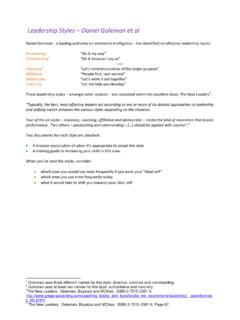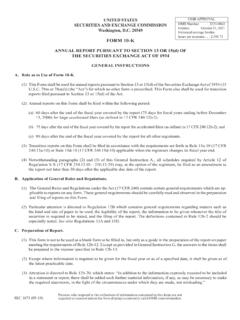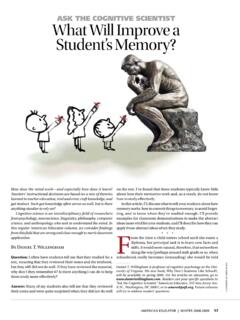Transcription of Daniel Goleman’s Emotional Intelligence Quadrant
1 OHIO STATE UNIVERSITY EXTENSION CFAES provides research and related educational programs to clientele on a nondiscriminatory basis. For more information: What is Emotional Intelligence ? By: Crystal Ott What is Emotional Intelligence ? Emotional Intelligence refers to the capacity to recognize and manage our own feelings and to recognize and respond effectively to those of others. There are various theorists who have developed different models of Emotional Intelligence . They are very similar but have a few variations in how they are structured. For the purposes of these lessons, we have chosen to use Daniel Goleman s model with four domains: self-awareness, self-management, social awareness and relationship management.
2 This was ori ginally developed in 1998 with five domains and redesigned in 2002 with four domains. Each domain has the connected competencies listed inside the boxes. The following pages briefly provide some background on each domain in the Quadrant . Daniel Goleman s Emotional Intelligence Quadrant Recognition/Awareness Self-Awareness Emotional self-awareness Accurate self-assessment Self-confidence Social Awareness Empathy Organizational Awareness Service Self-Management Emotional Self-Control Transparency Adaptability Achievement Initiative Optimism Relationship Management Influence Inspirational Leadership Developing Others Change catalyst Building bonds Conflict Management Teamwork & Collaboration Regulation/Control Goleman, D.
3 (1998). Working with Emotional Intelligence . New York: Bantam Books. Goleman, D., Boyatzis, R. & McKee, A. (2002). Primal Leadership: Realizing the Importance of Emotional Intelligence , Harvard Business School Press: Boston. Hughes, M. & Terrell, (2007). The Emotionally Intelligent Team. San Francisco: Jossey-Bass. Self Others Ohio 4-H Self- Awareness Emotional self-awareness Accurate self-assessment Self-confidence According to John Mayer (University of New Hampshire psychologist and one of the first to study Emotional Intelligence ) self-awareness is being aware of both our mood and our thoughts about mood. It is also explained by Goleman (2002) as the ability to read and understand your emotions as well as recognize their impact on others.
4 It can simply be put that self-awareness is a basic understanding of how we feel and why we feel that way. The more we are aware of our feelings that easier they are to manage and dictate how we might respond to others. Emotional awareness is the result of this sequence: 1. Sense the emotion (feeling) 2. Acknowledge the feeling 3. Identify more facts 4. Accept the feeling 5. Reflect on why the emotion is showing up in that moment. Notice what other feelings are present or came before it. Ask yourself what its purpose might be, what it is communicating, demonstrating, or trying to teach you. 6. Act bring your thoughts and feelings up and take appropriate action, if needed.
5 7. Reflect on the usefulness of the response and what lesson you would like to take away. The Emotionally Intelligent Team by Marcia Hughes and James Bradford Terrell, 2007, pg. 76-77 This sequence happens continuously all day long as each feeling comes into the picture. The importance of self-awareness is to better understand that these feelings are constantly coming and going and it is important to deal with them in an appropriate manner. It is equally important to be able to evaluate how this impacts the moods and emotions of others. There was a study done by Sigal Barsade (2002) on The Ripple Effect: Emotional Contagion and Its Influence on Group Behavior that shows that our emotions can be contagious and shared with others, even if we do not mean to.
6 There is a process innate in human behavior that can cause us to mimic another person s facial expressions and is communicated through nonverbal behaviors. The study also found we can influence each other socially; positive emotions towards others influenced cooperativeness and conflict in the study. Barsade, S. G. (2002). The Ripple Effect: Emotional Contagion and Its Influence on Group Behavior. Administrative Science Quarterly, 47, 644-675. Goleman, D., Boyatzis, R. & McKee, A. (2002). Primal Leadership: Realizing the Importance of Emotional Intelligence , Harvard Business School Press: Boston. Goleman, D. (2000). Leadership That Gets Results. Harvard Business Review, 78, 78-93.
7 Goleman, D. (1995). Emotional Intelligence . New York, New York: Bantam Dell. Hughes, M. & Terrell, (2007). The Emotionally Intelligent Team. San Francisco: Jossey-Bass. Salovey, P. & Mayer, J. D. (1997). Emotional Development and Emotional Intelligence . New York, New York: BasicBooks. Ohio 4-H Self-Management Emotional self-control Transparency Adaptability Achievement Initiative Optimism Self-Management, or self-regulation, can be defined as the ability to manage one s actions, thoughts, and feelings in flexible ways to get the desired results. Optimal self-regulation contributes to a sense of well-being, a sense of self-efficacy or confidence, and a sense of connectedness to others.
8 The goal is for a self-regulating individual to be able to take his or her Emotional responses as cues for both action and coping effectively in relationships. It is important to have an understanding of self-awareness first in order for this to be possible. Emotions can swamp the brain causing feelings of frustration and overwhelming thoughts. This is due to what Goleman (1995) calls an amygdala hijack . The amygdala is the area in the brain that is the center for the emotions and Emotional behavior. This area of the brain goes into overdrive causing high activity causing us to focus and obsess about whatever is causing our distress. It makes it very difficult to be able to think about anything else.
9 For example, you are working with your fellow teen leaders on planning an upcoming camp. Another counselor takes credit for your idea when sharing with the group. You get so focused on the unfairness of this that you miss what was said in the rest of the planning session. The goal of self-management is to be able to recognize these feeling as a hijack and bring the brain back to mental clarity and concentration to the task at hand. It is important to learn strategies to allow your brain to do this before responding to the negative emotions. Goleman, D. (1995). Emotional Intelligence . New York, New York: Bantam Dell. Goleman, D., Boyatzis, R. & McKee, A.
10 (2002). Primal Leadership: Realizing the Importance of Emotional Intelligence , Harvard Business School Press: Boston. Goleman, D. (2000). Leadership That Gets Results. Harvard Business Review, 78, 78-93. Salovey, P. & Mayer, J. D. (1997). Emotional Development and Emotional Intelligence . New York, New York: BasicBooks. Ohio 4-H Social Awareness Empathy Organizational awareness Service Social Awareness is the ability to accurately notice the emotions of others and read situations appropriately. It is about sensing what other people are thinking and feeling to be able to take their perspective using your capacity for empathy. Goleman explains, our ability actually comes from neurons in an extended circuitry connected to the amygdala.








